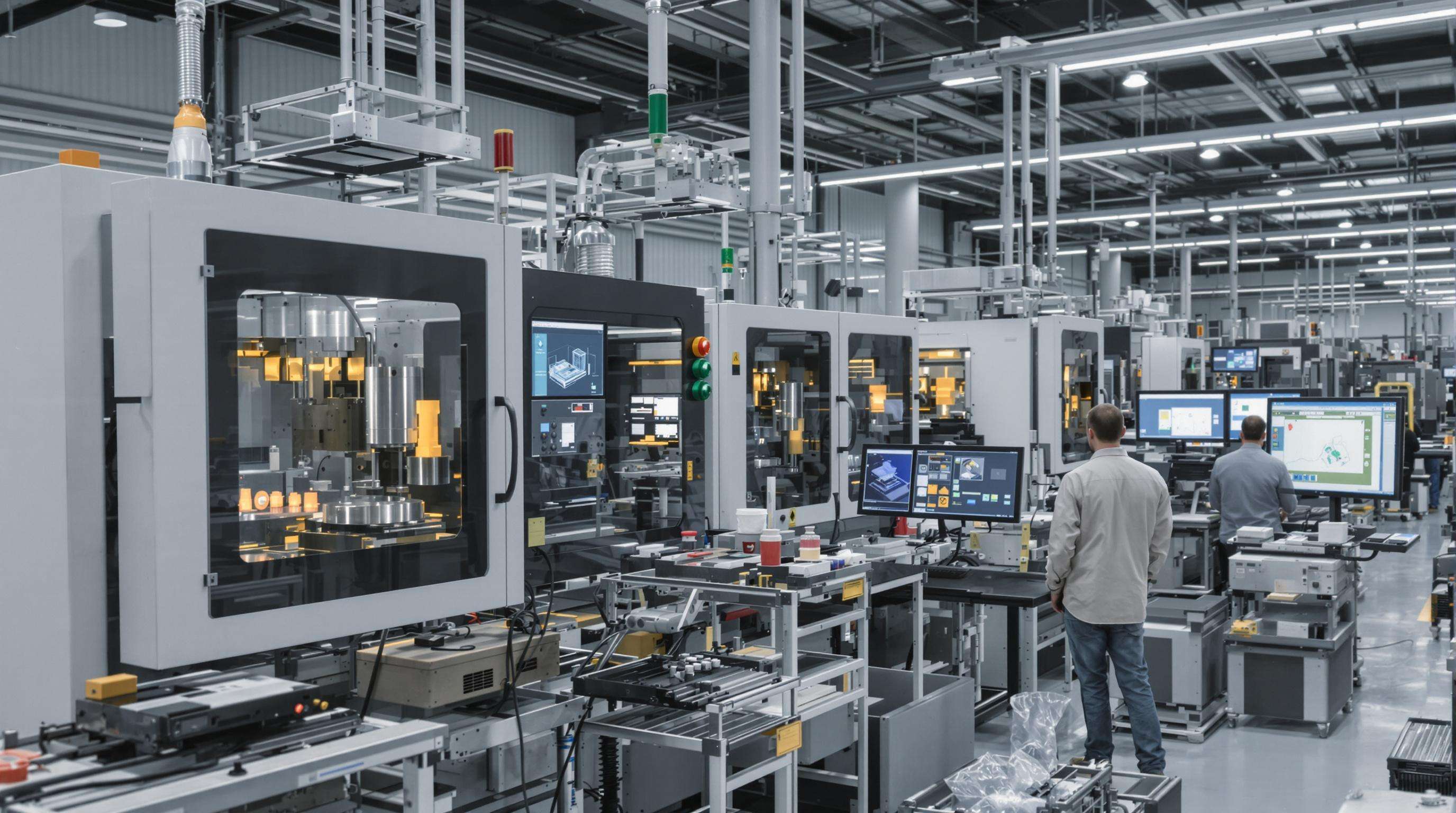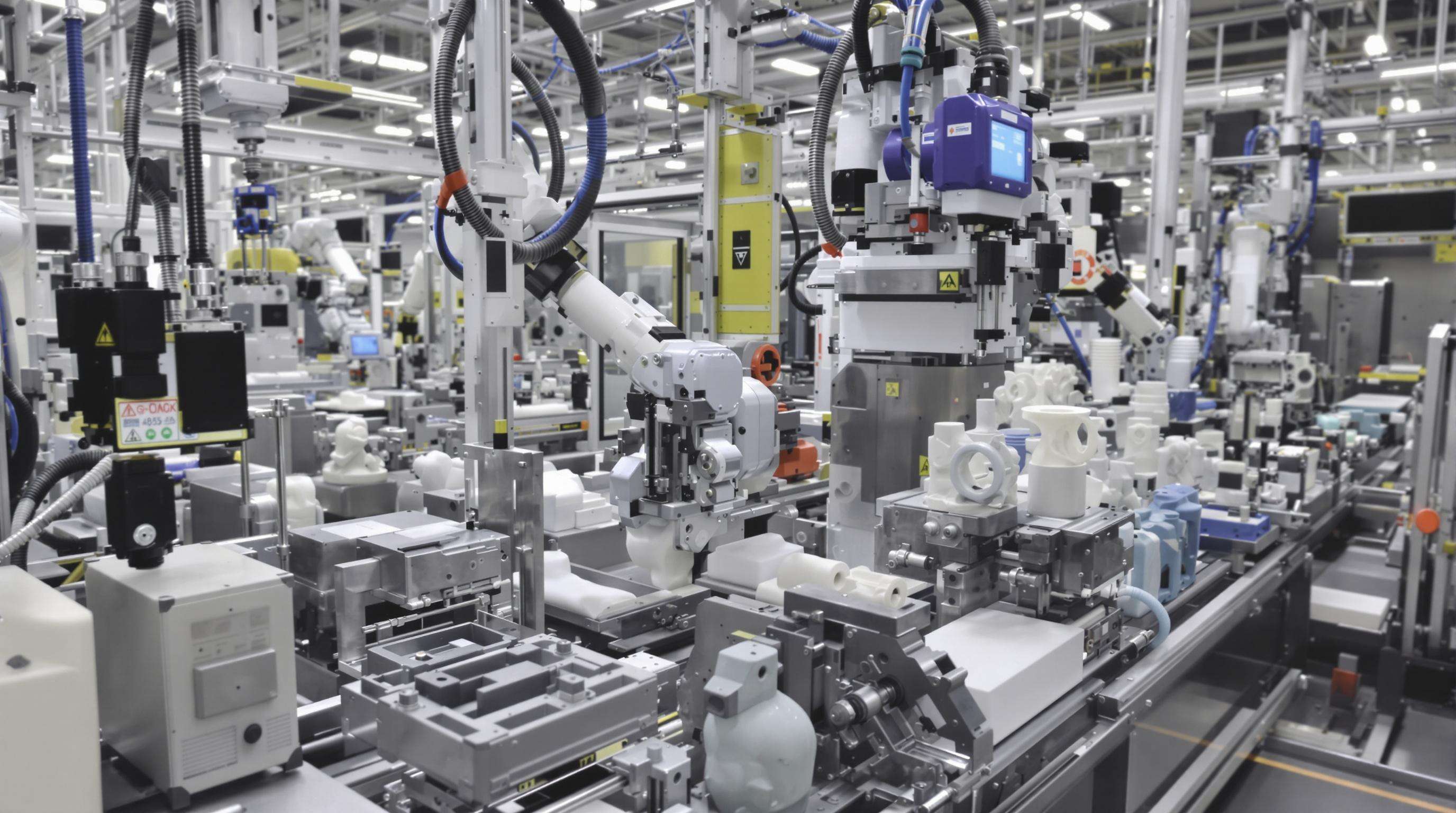
Современные высокоскоростные технологии выдувного формования позволяют производителям сократить сроки разработки продукции на 30–50% по сравнению с традиционным производством. Таким образом, внедряя передовые программные средства для проектирования пресс-форм и системы быстрой изготовления оснастки, производители могут перейти от дизайна к валидации за считанные недели вместо месяцев. Однако новые данные за 2024 год потрясли автомобильную и упаковочную отрасли — наши исследования показывают, что 73% автопроизводителей и компаний по производству упаковки отдают приоритет выдувному формованию для пилотного производства благодаря беспрецедентной скорости создания прототипов.
вставки для пресс-форм, созданные методом 3D-печати, изменили подход, устранив устаревшие ограничения традиционной обработки на станках с ЧПУ. Новые технологии выдувного формования сократили время разработки сложных корпусов для жидкостей с 14 до восьми недель у ведущего производителя корпусов. Ускорение этого процесса обеспечивается гибридными рабочими процессами для моделирования конструкции, управляемого симуляцией, и мониторинга технологических процессов в реальном времени, которые позволяют выполнять полностью интегрированную оптимизацию формы и верификацию материалов.
Преимущества данной технологии по времени распространяются не только на этап прототипирования — системы автоматической смены оснастки позволяют вносить корректировки, готовые к производству, за менее чем 12 часов вместо традиционных 5 дней для переоснащения. Для производителей медицинского оборудования это сократило задержки с одобрением FDA на 22% благодаря более быстрому итеративному тестированию критически важных компонентов, таких как камеры капельниц и системы доставки лекарств.
Системы гибридного литья-выдува (IBL) от New England Machinery обеспечивают точность литьевого формования, при этом добавляя функциональные возможности выдувания — всё в одной компактной машине — для достижения оптимального качества с повышенной эксплуатационной эффективностью, что позволяет сократить циклы разработки продукции и обеспечивает значительную экономию средств до 45% по сравнению с традиционными методами. Эти системы используют коэкструзионный слой для интеграции таких характеристик, как защита от ультрафиолета или конструктивные рёбра жёсткости непосредственно внутри полой детали, исключая необходимость вторичной сборки. В исследовании 2023 года было установлено, что гибридная технология IBL снижает расход материала на 28% при создании прототипов автомобильных бачков для жидкостей — за счёт минимизации толщины стенок на начальном этапе изготовления оснастки. Датчики давления в реальном времени мгновенно регулируют скорости потока расплава с точностью ±0,05%, обеспечивая одинаковое качество деталей от одного цикла литья к другому и от одной производственной партии к другой.
Для многополостных прототипов это позволяет быстро перенастраивать оборудование без необходимости полной смены формы. Электроприводные вставки обеспечивают возможность изготовления выемок и органических форм за время цикла 90 секунд или меньше — это критически важно для медицинских компонентов, соответствующих требованиям FDA по углам уклона. Один из производителей добился на 62% более быстрой верификации конструкции прототипов воздуховодов для авиакосмической отрасли, применяя гибридные формы из алюминиевого композита, рассчитанные на рабочую температуру до 350 °C. Эти инструменты даже способны обеспечить допуск 10 мкм на геометрическую точность, что позволяет выпускать детали со сложной геометрией или сечением неправильной формы.
Высокопроизводительные инженерные смолы, такие как модифицированный PETG, сейчас формуются на 15-20% быстрее и при этом соответствуют стандартам ASTM по ударной вязкости, что было невозможно ранее. Композитный материал содержит короткие волокна устойчивого происхождения, которые сокращают углеродный след на 19% на партию прототипов без потери механических характеристик за счет применения биополимеров (37% растительного содержания). Недавние достижения в области газонаполненных нано-наполнителей обеспечивают жесткость участков толщиной 0,8 мм на уровне конструкций без армирования толщиной 2 мм — это подтверждено в прототипах шарниров бытовой электроники, выдержавших более 50 000 циклов на усталость. Благодаря коэкструзии с использованием нескольких материалов стало возможным создание одностадийных прототипов с покрытиями мягких на ощупь (твердость по Шору А 50-90), непосредственно наносимыми на жесткие основы.

Использование унифицированных автоматизированных платформ в сочетании с минимально возможным ручным вмешательством для оптимизации производства методом выдувного формования. Эти системы согласовывают все производственные операции, начиная от подачи материала и заканчивая проверкой на выходе, чтобы можно было в реальном времени вносить корректировки с целью минимизации сроков выполнения и эксплуатационных затрат. Для OEM-производителей высокотехнологичных пластиковых компонентов такое сочетание технологий критично для сохранения конкурентоспособности, особенно при расширении объемов производства или внедрении принципов точного планирования (just-in-time).
Современные сенсорные сети отслеживают ключевые параметры, такие как профили температуры, давления и вязкости материала в процессе формования. Эти данные анализируются с помощью алгоритмов машинного обучения, которые сигнализируют о возможных сбоях и управляют автоматической корректировкой процесса для предотвращения дефектов. Такие системы способны к постоянной оптимизации, значительно сокращая время цикла и обеспечивая лучшее заполнение формы и точность геометрии деталей со сложными полыми участками. Несмотря на различия целевых показателей эффективности в зависимости от области применения, контроль качества в реальном времени остается решающим фактором в производстве упаковки для фармацевтики и жидкостных резервуаров для автомобилей, где требуется нулевая допусковая погрешность.
Роботизированные манипуляторы с визионным управлением для выброса деталей, обрезки литников и укладки на поддоны работают быстрее, чем человеческие руки. Они тесно интегрированы с формовочными машинами и извлекают детали в течение нескольких секунд после открытия формы — например, термочувствительные полимеры, которые необходимо быстро охладить для стабилизации. Освобождая ручные операции на предыдущих этапах, производители могут обеспечить непрерывное, а также круглосуточное производство изделий с высокими допусками, таких как воздуховоды для автомобилей или промышленные контейнеры. Инструменты на конце манипулятора также минимизируют микротрещины в тонкостенных конструкциях благодаря более точному позиционированию.
В более современных установках отработанное тепло от компрессоров и гидравлических агрегатов используется для предварительного нагрева измельчённого материала или регенерации осушителей в сушильной системе. Эта система замкнутого цикла позволяет утилизировать до 85% использованной воды и энергии, которые иначе были бы утрачены, значительно снижая потребление электроэнергии на цикл согласно отраслевым отчётам об устойчивом развитии. Более того, такие системы позволяют производителям соответствовать более строгим стандартам выбросов и уменьшают зависимость от невозобновляемой электроэнергии, поставляемой с сети.
Системы встроенного контроля на машинах литья выдуванием используют лазерные сканеры и камеры высокого разрешения для измерения распределения толщины стенок и обнаружения визуальных дефектов в точке производства. Любые отклонения приводят к немедленной корректировке программирования парисона или давления зажима, чтобы предотвратить дальнейшее распространение дефектов. Такой подход к устранению ошибок позволяет сэкономить на последующих процессах сортировки, что доказано быть важным преимуществом для производителей медицинских устройств, полностью соблюдающих протоколы стерильности. Предприятия перехватывают дефекты на корню, обеспечивая почти нулевой уровень брака — даже при работе со сложными полимерами.
Следует также учитывать, что топливные системы автомобилей требуют строгих сертификаций материалов, а также сложной геометрии с Система состояла из многокомпонентных форм с программированием заготовки с приводом сервопривода. Толщина стенок регулировалась за счет локального охлаждения и изменения давления надувания в реальном времени (± 0,25 PSI). Инструменты с выдвижными сердечниками для клапана улавливания паров топлива позволили обрабатывать участки с поднутрением без дополнительных операций механической обработки. Сменные зоны материала сваривались посредством вибрации в режиме выдувания. Такая адаптивная оснастка сократила время модификации формы на 60% — невозможно при использовании статичной оснастки. Быстрое изготовление алюминиевых форм позволяло перейти от цифрового моделирования к производству всего за 4 недели. После внедрения были получены следующие результаты: Инвестиции в размере $310 тыс. в оснастку полностью окупились менее чем за 9 месяцев благодаря ускоренному выводу продуктов на рынок и устранению затрат на вторичную обработку. Последующие модели включали одинаковые архитектуры оснастки, что сократило время разработки новых компонентов на 40% по всему портфелю. Масштабируемость производства позволила увеличить выпуск для удовлетворения всплесков спроса во время перебоев в цепочках поставок. Благодаря стратегическим альянсам OEM-производители могут максимально эффективно использовать литье с раздувом, объединяя ресурсы и экспертизу. Совместные проекты ускоряют сроки разработки за счет распределения инвестиций в НИОКР и передачи знаний между организациями. Предпочтительные поставщики утверждают, что при работе по интегрированной модели поставщиков внедрение оснастки ускоряется на 30–45 %, когда команды по науке о материалах и инженерные группы совместно разрабатывают решения. Это минимизирует риск капитальных затрат, позволяя собственным инновациям в процессах гармонично сочетаться с дизайном продукта. Поиск идеального производственного партнера — это не просто сравнение технических возможностей. Ставьте в приоритет поставщиков, которые могут предложить комплексные решения «под ключ», начиная с верификации прототипа и заканчивая готовностью к серийному производству и поддержкой вертикальной интеграции. Что следует учитывать: наличие сертифицированной по ISO системы контроля качества, а также совместимость материалов с вашими требованиями к термопластам в различных форматах. Такие сотрудничества обеспечивают синергетический эффект постоянного совершенствования процессов, что позволяет адаптировать производство к изменяющимся стандартам. Долгосрочные модели сотрудничества создают более глубокие стратегические преимущества, включая ускоренное прохождение испытаний на соответствие требованиям отраслевых нормативов. Партнеры предоставляют собственные данные моделирования для быстрой верификации проектов и планирования резервирования цепочек поставок в периоды пикового спроса. Такие альянсы превращают технические возможности в измеримые конкурентные преимущества благодаря совместному инжинирингу затрат и программам совместной операционной оптимизации. Технология выдувного формования позволяет OEM-производителям значительно сократить сроки разработки продукции, повысить скорость итераций прототипов и достичь экономии за счет более быстрых и эффективных производственных процесссов. Гибридное литье выдуванием сочетает в себе точность литья под давлением и функциональные возможности процесса выдувания в единой компактной системе, что позволяет сократить отходы материала, а также включить в полую деталь защиту от ультрафиолета и структурные ребра без необходимости вторичной сборки. Автоматизация повышает эффективность литья выдуванием за счет интеграции всех этапов — от подачи материала до проверки на выходе, обеспечивая оперативную корректировку параметров, сокращение сроков поставок и снижение эксплуатационных расходов. Стратегические партнерства позволяют OEM-производителям объединять ресурсы, распределять затраты на исследования и разработки, а также обмениваться знаниями между организациями, что приводит к более быстрому внедрению оснастки, минимизации капитальных рисков и согласованным инновациям в производственных процессах. Внедрение индивидуальной оснастки для выдувания
Метрики эффективности производства и анализ ROI
Метрический До внедрения После реализации Улучшение Годовой объем производства 18 тыс. единиц 34 тыс. единиц +89% Уровень брака 7.2% 1.8% -75% Срок окупаемости оснастки 16 месяцев 9 месяцев на 44% быстрее Стратегические модели партнерства для успеха OEM-производителей, основанного на технологии выдувного формования
Часто задаваемые вопросы
Каковы основные преимущества использования технологии выдувного формования для OEM-производителей?
Чем отличается гибридное выдувное формование от традиционных методов?
Какую роль играет автоматизация в процессах литья выдуванием?
Как OEM-производителям могут помочь стратегические партнерства при использовании литья выдуванием?
 Горячие новости
Горячие новости2024-10-29
2024-09-02
2024-09-02

Авторское право © 2024 Changzhou Pengheng Auto parts Co., LTD